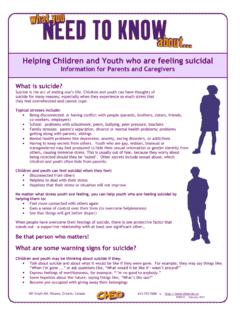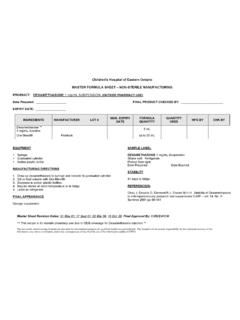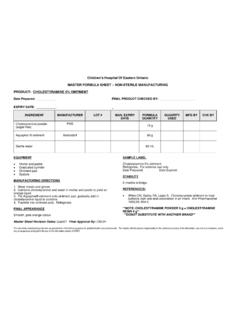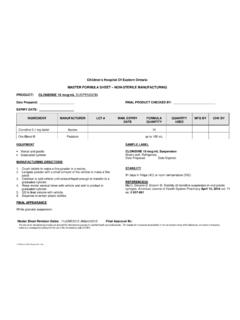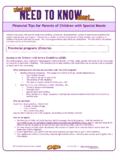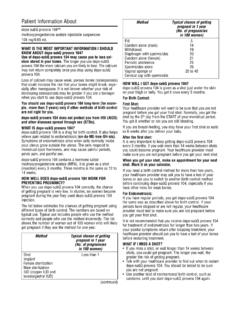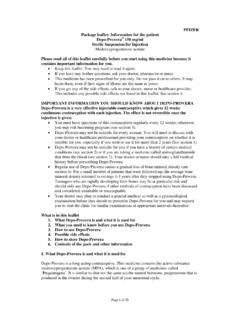Transcription of Occipital Plagiocephaly and Brachycephaly - CHEO
1 401 Smyth Road, Ottawa K1H 8L1 613-737-7600 Plagiocephaly and Brachycephaly What is Occipital Plagiocephaly ? Occipital Plagiocephaly is flattening of one side ofthe back of the baby s is Occipital Brachycephaly ?This is a flattening across the back of a baby s does this head flatteninghappen?Babies skull bones are very soft until they are abouta year old. If a baby lies in one position for a longtime, the soft skull bones can become flat. This candevelop over a few weeks or months. Puttingbabies to sleep on their backs has greatly reducedSIDS (Sudden Infant Death Syndrome), but somebabies develop a flat area on their heads. Some babies: Like to turn their heads to the same side when sleeping or sitting in a car seat or swing Are born with flat areas on their heads from their position in the womb. For example, twin babies don t have as much room to change position Keep their heads to one side because of a neck muscle problem, called torticollis Have softer skull bones (like premature babies) Do not turn their heads from side to side very much when sleeping or reclining For sleep: Place your baby on her back for sleep.
2 Babies who sleep on their backs have a reduced risk of SIDS (Sudden Infant Death Syndrome). Propping your baby on her side can increase the risk for SIDS. At about 5 months, babies can turn over onto their tummies by themselves. When this happens, you don t have to move your baby onto her back again. Move the crib so that your baby turns his head away from the flat area when she looks toward the door. Place toys and mobiles so your baby wants to turn away from the flat side. Tummy time. Give lots of supervised tummy and side lying time, when your baby is awake. This helps develop strong neck, shoulder and arm muscles. Find toys that your baby likes to play with on her tummy or side. Use your arms! Instead of walking with your baby in a car or infant seat, carry your baby close to your body in your arms or a cloth carrier you can wear. Exersaucer ! Give lots of supervised time to play in an Exersaucer , once your baby has good head control Avoid: Long periods in car seats, baby seats and swings where your baby s head is in the same position.
3 Pressure on the flat area of your baby s head when feeding, holding and carrying your baby. Encourage neck movement toward the non-flat side: Carry your baby on your hip, so that she must turn away from her favourite side to see ahead Use your voice and bright toys to encourage your baby to turn his head away from the flat side while he is playing, feeding or watching your baby off the flat area as much as possible. This will help your baby s head to go back to a rounder your baby s head has a flat head flattening causeproblems?Most of the time, having a flat spot will not affecta baby s brain growth or development. But arounded head shape helps a baby s shapes: Looking down on a baby s headWhat does it look like?PlagiocephalyYour baby will have a flat area at the side of the baby may also have: Changes to the face on the flat side of the head One ear that sticks outBrachycephalyYour baby s head will be flat across the back.
4 Yourbaby may also have: Widening of the face Increased height at the back of the head Ears that stick out on both sidesOccipital BrachycephalyOccipital PlagiocephalyNormal head more info? Numbers to Smyth Rd., Ottawa K1H 8L1 613-737-7600 Ottawa Public Health Info Line613-580-6744Te lehealth Ontario 1-866-797-0000 Health Information from Registered Nurses, 24 hours a day, 7 days a weekTTY: 1-866-797-0007 Your baby s head shapeForm # P5549E March 2015 What if my baby s head doesn tget better?Some babies with a severely flattened area mayneed to see a specialist and wear a molding with your family doctor if your baby s head isn tgetting Public Plagiocephaly and Brachycephaly What if my baby holds his head to one side or has trouble turning his head?Ask your doctor to check your baby s neck motion. Your baby may need neck stretching exercises at home, or with a physiotherapist.
5 Good neck motion is important for head reshaping.

